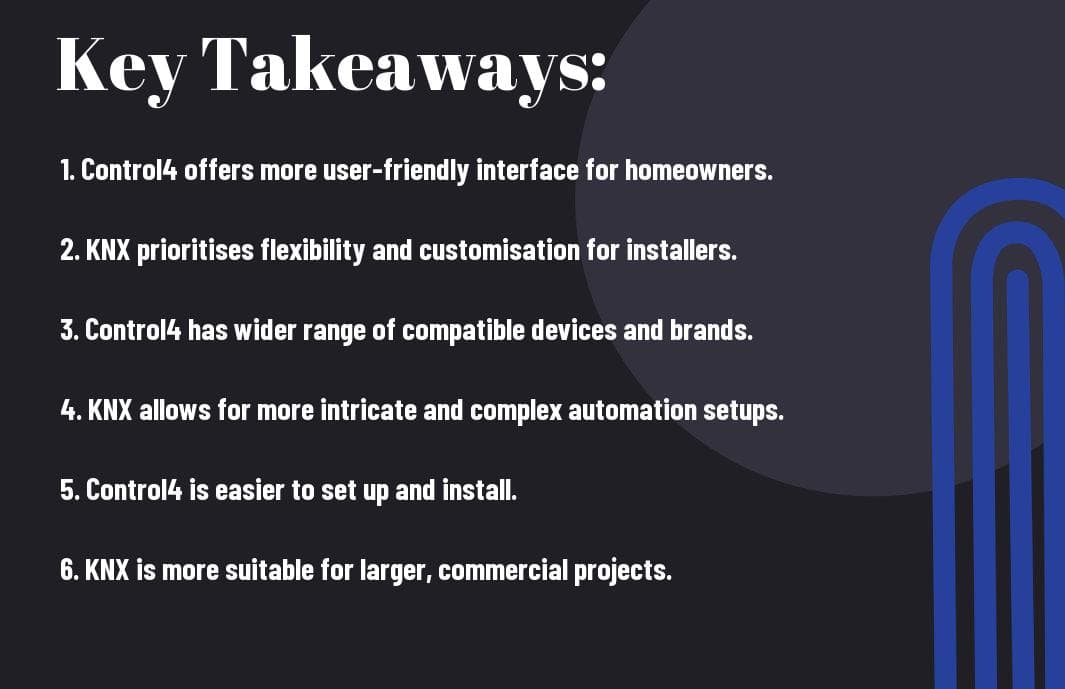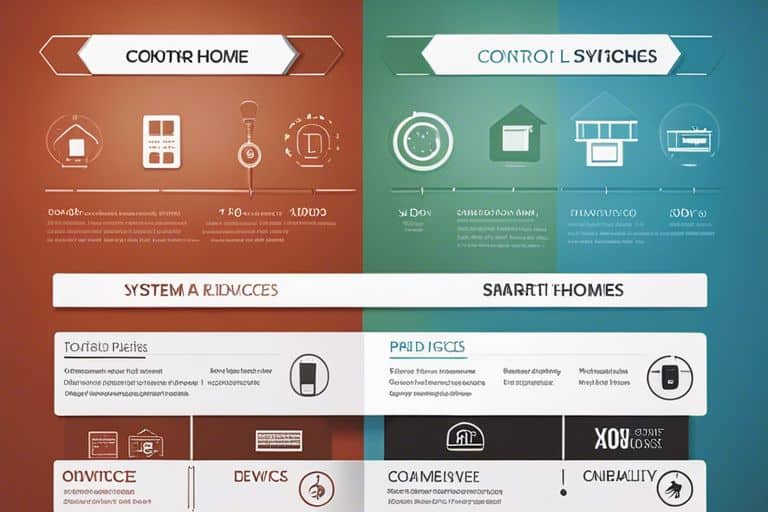Are you considering upgrading to a smart home system? When it comes to selecting the right smart home standard for your home, it’s important to compare the leading options. In this blog post, we’ll be comparing two popular choices – Control4 and KNX. We’ll examine the features, compatibility, and benefits of each system to help you make an informed decision. To learn more about the best smart home systems, check out this What is the best smart home system? | Control4, KNX, Savant guide.
Key Takeaways:
- Interoperability: Control4 and KNX both offer interoperability, but Control4’s system is designed to work seamlessly with various third-party devices, while KNX is more reliant on its own ecosystem of products.
- Scalability: Control4 is known for its flexibility and scalability, making it suitable for smaller residential projects as well as larger commercial installations. On the other hand, KNX is often better suited for larger, complex projects due to its extensive capabilities.
- Customisation: While both systems offer customisation options, Control4’s user-friendly interface allows for easier personalisation and programming, making it more accessible to homeowners. KNX, on the other hand, offers a higher level of customisation but may require professional programming assistance.

Analysing Smart Home Ecosystems
When comparing smart home standards such as Control4 and KNX, it’s important to understand the core features and capabilities of each ecosystem. This will help you make an informed decision about which system is best suited to your specific requirements.
Core Features of Control4
Control4 offers a comprehensive range of smart home features, including lighting control, security, climate control, and entertainment. The system is designed to be user-friendly, with a single interface that allows you to control all aspects of your home from one central location. Control4 also supports a wide range of third-party devices and integrates with popular voice control platforms such as Amazon Alexa and Google Assistant.
// Example Control4 code snippet
home.lights.dim('kitchen', 50);
Core Features of KNX
KNX is a highly flexible and robust smart home standard that is based on an open protocol, allowing for seamless integration with a wide range of devices and systems. The system is known for its reliability and interoperability, offering support for a variety of communication protocols including TCP/IP, RF, and powerline. KNX also provides advanced features such as built-in logic functions and scheduling capabilities.
// Example KNX code snippet
device.sendCommand('kitchenLight', 'on');
Configuration and Customization Practices
When it comes to configuring and customizing your smart home system, Control4 and KNX offer different approaches. Let’s take a closer look at the practices involved in setting up and personalizing these systems.
Configuring Control4 Systems
Configuring your Control4 system involves using Composer Pro software to establish connections, set up devices, and create customized actions. The programming language used in Control4 is based on Lua, which allows for flexibility and extensive customization. Below is an example of configuring a scene in Control4:
function Scene1()
local light1 = Lighting:get("Light1")
light1:dim(50) -- Dim the light to 50%
end
Configuring KNX Systems
Configuring your KNX system involves using ETS (Engineering Tool Software) to program devices, group addresses, and create logic functions. KNX systems use a standardized programming language, making it more straightforward for installation and commissioning. Here is an example of configuring a scene in KNX:
IF switch1 = on AND switch2 = on THEN
light1 = on
ENDIF
In Control4, you have the flexibility to write custom scripts using Lua, allowing you to create intricate and specific automation sequences. However, this also means there is a steeper learning curve and a potential for errors in your programming. On the other hand, KNX follows a standardized programming language, which provides a more straightforward approach to configuration but may limit flexibility for complex customizations. Understanding these differences will help you determine which system better suits your needs for configuration and customization.
When setting up your Control4 system, you have the ability to fine-tune and tailor your automation to your exact specifications. However, this advanced level of customization does require a deep understanding of programming and automation logic. On the other hand, KNX systems offer a more standardised and user-friendly approach to configuration, making it easier to set up and commission your smart home. This can be advantageous for those who want a more plug-and-play experience, but it also means you may have less flexibility in customizing your system to unique preferences.
Performance and Optimization
When it comes to the performance and optimization of smart home systems, both Control4 and KNX offer robust solutions that can be tailored to meet your specific requirements. Control4’s programming language Composer Pro allows for advanced customization of your smart home, while KNX’s open-source nature enables seamless integration with a wide range of devices and systems. Let’s take a closer look at how each system performs and can be optimized to suit your needs.
Testing and Comparing System Performance
Testing and comparing the performance of Control4 and KNX systems is essential to ensure that they meet your functional and operational requirements. Control4’s Composer Pro offers a comprehensive suite of tools for monitoring and analysing system performance, allowing you to identify and address any potential bottlenecks or issues. KNX, on the other hand, provides open-source diagnostic tools that enable you to identify and troubleshoot performance issues effectively.
// Sample code for testing Control4 system performance
composer.systemPerformance.test()
// Sample code for testing KNX system performance
knx.diagnosticTools.testPerformance()
For further insights into the performance of KNX and Control 4 systems, you can read a case study on how KNX and Control 4 integrate for unified control of Belgian smart home.
Tools and Scripts for Optimizing Smart Homes
Optimizing your smart home system is crucial to ensure that it operates efficiently and securely. Control4 offers a range of tools and scripts that allow you to optimize system performance, automate routine tasks, and enhance security. Similarly, KNX provides a variety of open-source tools and scripts that enable you to fine-tune system performance and ensure seamless integration with third-party devices and systems.
// Sample script for optimizing Control4 system
composer.optimization.runScript('performance')
// Sample script for optimizing KNX system
knx.optimization.run('security')
Common Mistakes to Avoid and Useful Formatting Strategies
When it comes to smart home standards like Control4 and KNX, there are some common mistakes that you should avoid to ensure a smooth implementation. Additionally, using useful formatting strategies can make the process more efficient and effective. Let’s take a look at some of these considerations.
Control4 Configuration Pitfalls
One common mistake when configuring Control4 systems is overlooking the importance of proper network setup. Ensure that your network infrastructure is robust and reliable to avoid potential connectivity issues. Additionally, make sure to double-check your device compatibility to prevent any unexpected setbacks during the implementation process.
network {
name: "YourNetwork";
security: WPA2;
devices: "Device1", "Device2";
}
KNX Implementation Missteps
When it comes to implementing KNX, one misstep that you should avoid is failing to adhere to the KNX standard protocol. Make sure that all your KNX devices are compliant with the standard to ensure seamless integration and operation. Additionally, overlooking the importance of proper bus topology and addressing can lead to communication issues within the KNX system.
knx {
protocol: "KNXnet/IP";
devices: "DeviceA", "DeviceB";
topology: "Bus";
address: "0.0.1";
}
It’s important to be mindful of these pitfalls and missteps to avoid potential setbacks during the implementation of Control4 and KNX systems. By addressing these issues proactively, you can ensure a smoother and more successful integration of smart home standards into your environment.
For more in-depth insights into the ‘˜KNX’ factor, you can read the article The ‘˜KNX’ factor on HiddenWires website.
Conclusion
From above, it’s clear that both Control4 and KNX offer robust smart home standards with their own distinct advantages and limitations. Your choice between the two will greatly depend on your specific needs, budget, and technical expertise. Control4’s user-friendly interface and extensive compatibility make it a great option for beginners and those looking for a seamless integration with other smart devices. On the other hand, KNX’s open protocol and flexibility make it a solid choice for those with more advanced technical know-how and a desire for customisation. Ultimately, the best smart home standard for you will be the one that aligns most closely with your individual requirements and preferences.
Smart Home Standards Compared – Control4 vs KNX
Q: What is Control4?
A: Control4 is a smart home automation system that integrates various devices and systems within a home, allowing for seamless control and automation of lighting, heating, security, and entertainment.
Q: What is KNX?
A: KNX is a global standard for home and building control that enables the integration and control of various devices and systems, providing a flexible and interoperable smart home solution.
Q: How do Control4 and KNX differ in terms of compatibility?
A: Control4 is compatible with a wide range of devices and brands, offering extensive integration options. KNX, on the other hand, is based on a strict standard for device communication, ensuring a high level of interoperability among different manufacturers.
Q: Which system offers more flexibility and customisation options?
A: Control4 provides extensive customisation and flexibility, allowing users to tailor their smart home experience to their specific needs and preferences. KNX also offers a high degree of flexibility, with the ability to customise and expand the system as required.
Q: What about scalability and future-proofing?
A: Control4 is well-suited for both small-scale and large-scale installations, with the ability to expand and upgrade the system as technology advances. KNX is designed to be highly scalable and future-proof, offering long-term support and compatibility.
Q: How do Control4 and KNX compare in terms of installation and maintenance?
A: Control4 systems are typically installed and maintained by certified dealers and technicians, ensuring a high level of expertise and support. KNX installations require trained professionals for setup and configuration, with maintenance being relatively straightforward once the system is in place.
Q: What are the cost considerations for Control4 and KNX?
A: Control4 systems can be tailored to fit a range of budgets, with the ability to start small and expand over time. KNX installations may require a larger upfront investment due to the need for specific KNX-certified products, but the long-term flexibility and compatibility can offset initial costs.
